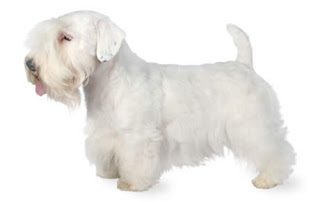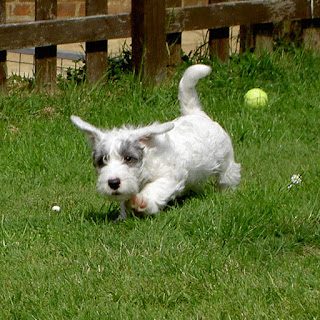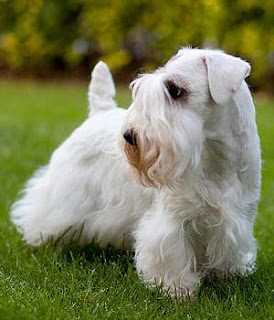Everything about your Sealyham Terrier
The Sealyham Terrier dog breed was originally bred to hunt otters, foxes, and badgers. Today these clowns of the terrier family are primarily companion dogs and a good choice for the novice terrier owner.
Overview
The Sealy peers out at the world from beneath bushy eyebrows, ever curious about the goings-on around him. Although he certainly has the look of a feisty terrier, the Sealyham Terrier doesn’t have the typical attitude. He’s a very mellow, laid-back dog, with modest exercise requirements and a clownish spirit. He even gets along well with other dogs. All these traits serve to make him a good pet for someone who loves the high-style look of a terrier but isn’t enamored with or capable of handling that in-your-face kind of dog.
The Sealyham Terrier is all terrier on the outside, with the scruffy charm of his cousins and the white color of his ancestor, the West Highland White Terrier. But on the inside he’s a very different dog.
Originally bred to hunt badger, he’s better described as a lover, not a fighter. He’s a playful dog with a big sense of humor, and while he has a tendency to bark a bit more than most people might like, at only 20 to 25 pounds he is the perfect size for an apartment. He’s a light shedder, inclined to be child-friendly and dog-friendly, and doesn’t even have an overwhelming desire to chase cats.
Highlights
- If your Sealyham Terrier becomes overweight, he can develop back problems. Be sure to monitor his food intake and give him regular exercise to keep him in shape.
- Sealies are independent and can be stubborn when it comes to housetraining. Crate training is recommended.
- They are reserved with strangers and make good watchdogs. Their bark is surprisingly loud and deep, but they can be trained to be quiet on command.
- Sealies are fond of chasing rabbits, birds, and even other dogs and cats. Be sure to keep your Sealyham Terrier on leash when he’s not in a secure area.
- Because of their unusual looks and small size, they could be targets for dog thieves. Although Sealyham Terriers do well outdoors when it’s cool (they don’t like heat), they should be kept in your house when you can’t supervise them.
- Sealyham Terriers are a rare breed. It may be difficult to locate a reputable breeder, and even when you locate one, you may have to wait several months for a litter to be born.
- Sealyham Terriers can be aggressive toward dogs they don’t know, even dogs much larger than they are. Keep your Sealyham Terrier under control until you know that both he and the other dog are friendly to each other.
- Although loyal and affectionate with their families, Sealyham Terriers can be a bit reserved around strangers.
- Sealyham Terriers are happy little dogs, but they can have a dominant personality if not kept in check by a firm, consistent master.
- Sealyham Terriers have an independent, stubborn streak. Successfully training them requires firm, consistent handling. They respond well to positive reinforcement techniques such as food rewards, praise, and play.
- Never buy a Sealyham Terrier from a puppy mill, a pet store, or a breeder who doesn’t provide health clearances or guarantees. Look for a reputable breeder who tests her breeding dogs to make sure they’re free of genetic diseases that they might pass onto the puppies and who breeds for sound temperaments.
- The Sealyham’s long, broad head and rectangular body are two of the features that differentiate him from other terriers.
- The Sealyham’s double coat can be all white or white with lemon, tan or badger markings on the head and ears. “Badger” is a mixture of white, gray, brown and black hairs.
- Comparable Breeds: Dandie Dinmont Terrier, West Highland White Terrier
 This breed needs a daily walk. Play will take care of a lot of their exercise needs, however, as with all breeds, play will not fulfill their primal instinct to walk. Dogs that do not get to go on daily walks are more likely to display behavior problems. They will also enjoy a good romp in a safe, open area off lead, such as a large, fenced-in yard. The breed is a low-energy dog that makes a good walking companion. The overriding characteristic about Sealyhams is that they are low energy, couch potatoes. They are not “busy,” not “active” and therefore make a low-key companion.
This breed needs a daily walk. Play will take care of a lot of their exercise needs, however, as with all breeds, play will not fulfill their primal instinct to walk. Dogs that do not get to go on daily walks are more likely to display behavior problems. They will also enjoy a good romp in a safe, open area off lead, such as a large, fenced-in yard. The breed is a low-energy dog that makes a good walking companion. The overriding characteristic about Sealyhams is that they are low energy, couch potatoes. They are not “busy,” not “active” and therefore make a low-key companion. The Sealy doesn’t shed much at all, but his hard terrier coat may need special care. If the show ring is in his future, the Sealyham’s coat will have to be “hand-stripped,” a labor-intensive task that involves pulling out dead coat a little bit at a time, using a special tool. Dogs whose career involves your sofa and garden will simply need to be kept brushed and occasionally clipped for neatness and to minimize shedding and matting of the coat. Clipping will soften the texture of the coat, so think about whether that’s important to you before you have it done.
The Sealy doesn’t shed much at all, but his hard terrier coat may need special care. If the show ring is in his future, the Sealyham’s coat will have to be “hand-stripped,” a labor-intensive task that involves pulling out dead coat a little bit at a time, using a special tool. Dogs whose career involves your sofa and garden will simply need to be kept brushed and occasionally clipped for neatness and to minimize shedding and matting of the coat. Clipping will soften the texture of the coat, so think about whether that’s important to you before you have it done.






